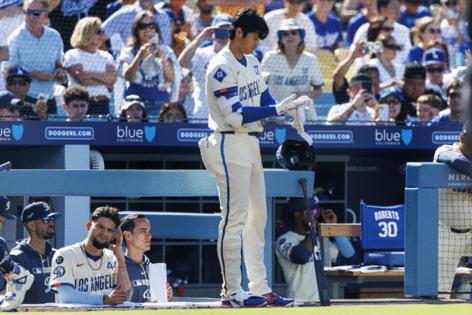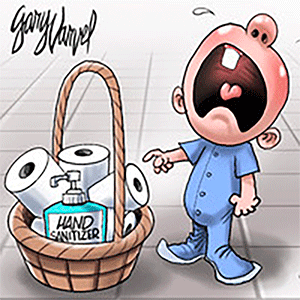'Really impressed.' Shohei Ohtani's return to two-way role going (mostly) well a month in.
Published in Baseball
LOS ANGELES — His breaths were heavy. His answers were interrupted by deep inhales. And beads of sweat were dripping from his forehead.
Tired? Perhaps.
But personally invigorated? There seemed little doubt.
For the newly turned 31-year-old Shohei Ohtani, the deep breaths and sweat drips were just a sign of another day's work in his return to full-time two-way duties, coming as he spoke to reporters following his latest game as both starting pitcher and designated hitter for the Dodgers on Saturday.
"As long as I can play the way I want to play," Ohtani said through interpreter Will Ireton as he celebrated his birthday, "I usually spend my birthday just like any other day."
The way Ohtani wants to play, of course, is exactly how he's been doing it for the last month. After being unable to pitch for the first year and a half of his Dodgers tenure — limited only to hitting while recovering from a second career Tommy John surgery — he is finally back to being a fully healthy two-way star, taking the mound once per week in addition to leading off the lineup every day.
Four weeks into his return to pitching, the results have been (mostly) positive for the reigning National League MVP.
In six innings as a pitcher, he has given up just one run, four hits and four walks while striking out six batters (a quality start by any definition of the term, if considered as one pitching outing).
And as a hitter, he is still posting MVP-caliber numbers, entering Monday leading the National League with 30 home runs and a .610 slugging percentage, while ranking second in OPS (.990, behind only teammate Will Smith), 13th in RBIs (56) and 23rd in batting average (.278).
"He's just handling it the right way," manager Dave Roberts said a few weeks ago, personally amazed at watching Ohtani's two-way talents up close for the first time. "He's just unflappable."
The most encouraging signs over the last month have been with Ohtani's progression on the mound.
Even after a second major elbow surgery, he is still routinely eclipsing 100 mph with his fastball, while commanding it in different parts of the strike zone. He has quickly rediscovered the feel for his breaking stuff, generating whiffs with his sweeper and traditional slider. He's also doing it with a new, slightly lowered arm angle, one that Roberts said he didn't develop by accident.
"He understands his delivery and what he's trying to do," Roberts said. "So obviously coming off the second Tommy John, I think this probably puts his arm in the best position, [where he] feels best. I like where he's at."
The only missing piece to Ohtani's pitching remains the length of his outings.
So far, he has yet to pitch past the second inning. And while Roberts called it "feasible" for him to get stretched out to five or six innings, the team still doesn't "know what that's going to be," he said.
"In a rehab progression, it's really important to just take one step at a time," Ohtani echoed. "There are times when I may be able to go another inning, but it's really important not to take unnecessary risks and make sure that I can progress consistently. It's always been this way in terms of my rehab progression. So I'm following what the team is also asking me as well."
The big question, to this point, is how much Ohtani's return to pitching has impacted his potency with the bat.
At various points since June 10, when Ohtani ramped up to three innings in his final simulated live session before returning to game action as a pitcher, Roberts has noted some normal instances of fatigue that Ohtani has felt.
The slugger's hitting numbers have ticked down in that span as well, with Ohtani batting only .239 since that day — albeit with seven home runs in 24 games and a robust .919 OPS.
On days he pitches, Ohtani has still gone 5 for 16 with a double, triple and home run. On the days immediately after a pitching outing, however, he is 0 for 12 with less hard contact than his thunderous swing usually produces.
There have also been incremental drops in some of Ohtani's underlying numbers, including exit velocity (95.5 mph average before May 10; 93.3 mph average since) and swing speed (76.3 mph before; 75.8 mph since) according to data from Baseball Savant.
The decline hasn't been lost on Ohtani.
On Saturday, he said he doesn't "feel too bad at the plate" physically, but acknowledged he hasn't punished mistakes as well as he typically does.
"Usually, it's a matter of just a little bit of a difference in the way that I'm swinging," he said. "So just have to find it in the cage work, and hopefully be able to apply that on the field."
Roberts also downplayed the notion as the product of a small sample size, insisting he hasn't seen "much of a difference" in Ohtani at the plate since he resumed his two-way duties.
"I think he's still taking good at-bats," Roberts said. "I still don't mind where he's at right now."
It will, nonetheless, be a dynamic the Dodgers closely monitor as Ohtani continues to try and maximize his dual talents. The longer his offensive numbers drag down, the more caution the club could exercise in his long-term pitching plan.
His bat, after all, remains the single most valuable tool on the team's entire roster — with the Dodgers wanting to ensure, above all else, he can be a force at the plate as they try to defend their World Series title.
But, on the whole, his pitching progress has been stark during his first month back as a two-way player, and his overall production is still among the best in baseball; with his 4.4 total wins above replacement, according to Fangraphs, trailing only breakout Cubs star Pete Crow-Armstrong for the best mark in the NL.
"[I've been] really, really impressed," Roberts said Saturday, after getting his latest look at two-way Ohtani, "how he's continuing to get better and better each time out."
____
©2025 Los Angeles Times. Visit latimes.com. Distributed by Tribune Content Agency, LLC.







Comments